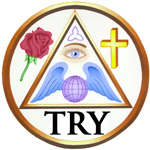Legend Has It ... Secret Societies, Part 2
- Heather Slawecki
- Jan 11, 2020
- 4 min read
Updated: Dec 29, 2020
"Even those who have dedicated their lives to studying a particular Rosicrucian path may not understand anything about Rosicrucianism."
- Samuel Robinson, founder of Pansophers

Image from the Rosicrucian Egyptian Museum, San Jose, California
Above are symbols representing five Orders. Top left in order: The Rosy Cross (a symbol shared across Orders); The Hermetic Order of the Golden Dawn; Fraternitas Rosæ Crucis. Bottom row: Ancient Mystical Order Rosae Crucis; Builders of the Adytum; Memphis Misraim.
Rosicrucian History
In part 1, we discussed secret societies as a whole, then delved into esotericism, which brought us to Rosicrucianism. We'll explore Rosicrucianism for the rest of this series. I can tell you, there's no easy way to fully explain what Rosicrucianism is, and each Order has its own unique definition and path. Since I belong to AMORC, I'm going to use them as a reference to help you understand it a little. I don't pretend to be an expert, therefore, I'm quoting just a few short paragraphs verbatim from Rosicrucian.org.
"The Rosicrucian movement, of which the Rosicrucian Order, AMORC, is the most prominent modern representative, has its roots in the mystery traditions, philosophy, and myths of ancient Egypt dating back to approximately 1500 BCE. In antiquity the word “mystery” referred to a special gnosis, a secret wisdom. Thousands of years ago in ancient Egypt select bodies or schools were formed to explore the mysteries of life and learn the secrets of this hidden wisdom."
"In the late seventeenth century, following a plan originally proposed by Francis Bacon in The New Atlantis, a colony of Rosicrucian leaders was organized to establish the Rosicrucian arts and sciences in America. In 1694 Rosicrucian settlers made the perilous journey across the Atlantic Ocean in a specially chartered vessel, the Sarah Maria, under the leadership of Johannes Kelpius, master of a Rosicrucian Lodge in Europe. Landing in Philadelphia, the colonists established their first settlement and later moved further west in Pennsylvania to Ephrata. These Rosicrucian communities made valuable contributions to the newly emerging American culture in the fields of printing, philosophy, the sciences and arts. Later such eminent Americans as Benjamin Franklin, Thomas Jefferson, and Thomas Paine were intimately connected with the Rosicrucian community. In fact, many Rosicrucians played an important role in the great alchemical and social process leading to the founding of a new nation.

In 1909 the American businessman and philosopher, H. Spencer Lewis, journeyed to France, where he was duly initiated into the Rosicrucian Order and chartered with the responsibility of renewing Rosicrucian activity in America. With H. Spencer Lewis as its president, the Rosicrucian Order, AMORC, was incorporated in 1915 in New York City. In 1927 the Order moved its headquarters to San Jose, California—the site of present-day Rosicrucian Park."
H. Spencer Lewis was from Frenchtown, NJ
More images from the Rosicrucian Egyptian Museum, San Jose, California
Very prominent members from the past
"Throughout history a number of prominent persons in the fields of science and the arts have been associated with the Rosicrucian movement, such as Leonardo da Vinci (1452-1519), Cornelius Heinrich Agrippa (1486-1535), Paracelsus (1493-1541), François Rabelais (1494-1553), Theresa of Avila (1515-1582), John of the Cross (1542-1591), Francis Bacon (1561-1626), Robert Fludd (1574-1637), Jacob Boehme (1575-1624), René Descartes (1596-1650), Blaise Pascal (1623-1662), Baruch Spinoza (1632-1677), Isaac Newton (1642-1727), Gottfried Wilhelm Leibnitz (1646-1716), Benjamin Franklin (1706-1790), Thomas Jefferson (1743-1826), Michael Faraday (1791-1867), Ella Wheeler Wilcox (1850-1919), Marie Corelli (1855-1924), Claude Debussy (1862-1918), Erik Satie (1866-1925), and Edith Piaf (1916-1963)." Rosicrucian.org.
How many Orders are there?
Getting back to all things Rosicrucian, there are more than a dozen known Orders. Sam Robinson continues to study each Order and has a grading system to determine authenticity. I go by Sam. AMORC member or not, I trust him completely to interpret each sect. He's traveled and studied all over the globe to gather information and insight. Take a few minutes to click on the link below for a look at his thoughtful reviews and grading systems. While you're at it, dig around his blogs a little. I learn something new every time I go into his site.
Discrediting Rosicrucianism
If you Google Rosicrucianism, you'll find many people discrediting them altogether as a faux society.
The Order of the Rosy Cross contains all the mystery and adventure to garner attention. According to their own myth, laid down in the Rosicrucians' three defining pieces of literature, German doctor Christian Rosenkreuz started the Order at the turn of the 15th century. Rosenkreuz, according to three books released at the beginning of the 17th century, had journeyed across the Middle East toward Jerusalem, amassing ancient wisdoms from sages. He later shared it with a small brotherhood upon his return to Germany, who became the first Rosicrucians. This fellowship believed that the secret knowledge Rosenkreuz brought with him, which blended science, arts, alchemy and mysticism, led to personal enlightenment for the initiated.
While the Rosicrucians may not have existed as an actual secret society, they've helped inspire several real organizations. The Freemasons took great inspiration from the Rosicrucian belief in hidden knowledge leading to enlightenment. Rosicrucian ideals also led to the founding of the Ancient Mystical Order Rosae Crucis in France in 1909. They maintain their beliefs date back to ancient Egyptian mysticism and were established with the aim of preserving the teachings of the universe, its nature and its human inhabitants.
Taken from Newsweek Article: Shadows in the Shadows: The Rosicrucians, a Fake Secret Society, Had a Real Impact on the World. For the full read, visit:



















Thank you for your background on the subject. Definitely looking to keep any historical information accurate.
Johannes Kelpius was not a Rosicrucian nor does AMORC have any direct affiliation with the German Piests of Pennsylvania.